Top 4 Gentle Algae Eaters For Aquariums
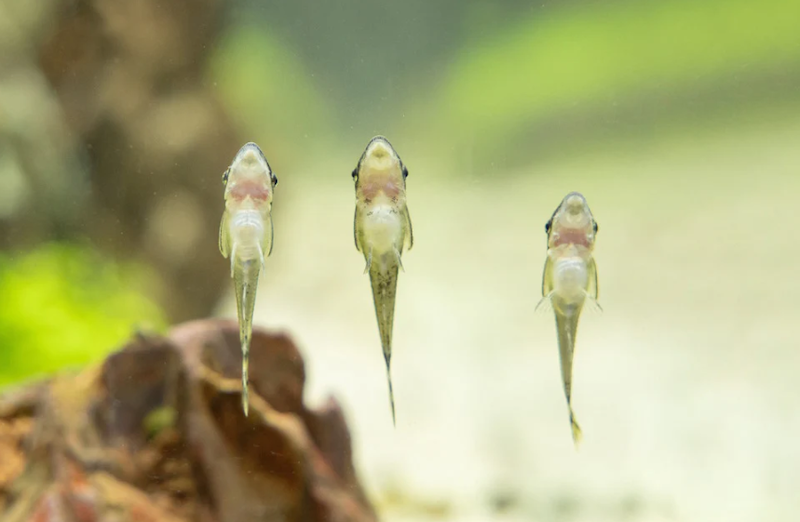
Are algae eaters aggressive? Algae eaters are essential for maintaining a clean and healthy aquarium, but their behavior can vary significantly. Some algae eaters are peaceful, while others may exhibit aggressive tendencies. This comprehensive guide will help you understand the behavior of different algae-eating fish and how to manage any aggression in your tank.
Siamese algae eater fish
Overview
Siamese algae eater fish are the most popular algae eaters for the fish tanks because they spend most of their time eating moss and dirt to clean the aquarium. The Siamese algae eater has a torpedo-shaped appearance with a sharp snout, looking like a miniature freshwater shark.
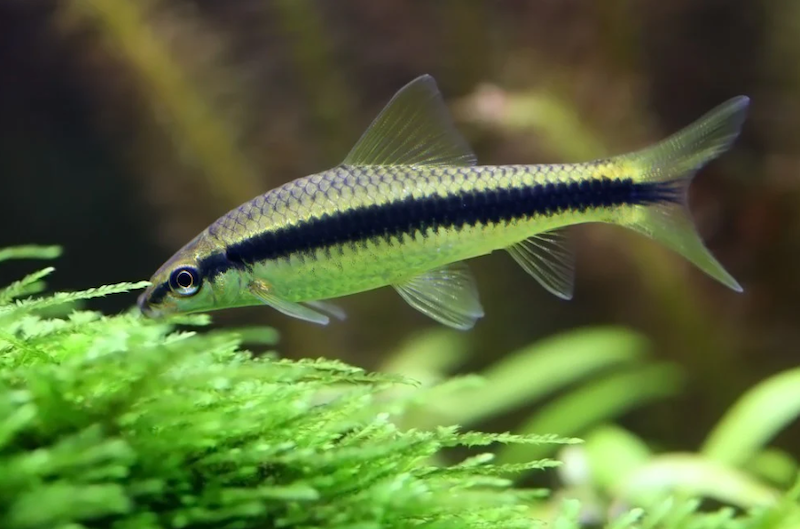
The outlook of Siamese algae eater fish has a bold, black line running down its side with a tannish-gray back and lighter underside. The fins and tail are completely clear. Their size can reach up to 15 cm (6 inches) in length. Both males and females look the same but female fish will have a thicker and bigger body size.
Habits
Here are some general habits of Siamese algae eater fish:
- They are friendly fish that can easily get along with a different group of other fish types. Siamese algae eater fish is one of the best tankmates in aquariums.
- Are Siamese algae eaters aggressive? Yes, they will turn aggressive if the tank gets overcrowded and no shelters exist or they feel alone.
Moreover, this fish is extremely energetic and would love to move all day. Hence, you need to ensure to prepare a spacious tank for them,
Habitat
The habitats of Siamese algae eater fish are simple. Because they originate from clear streams and rivers in Southeast Asia, they prefer to live in a tank with many rocks, wood, and plants as shelters for them to hide.
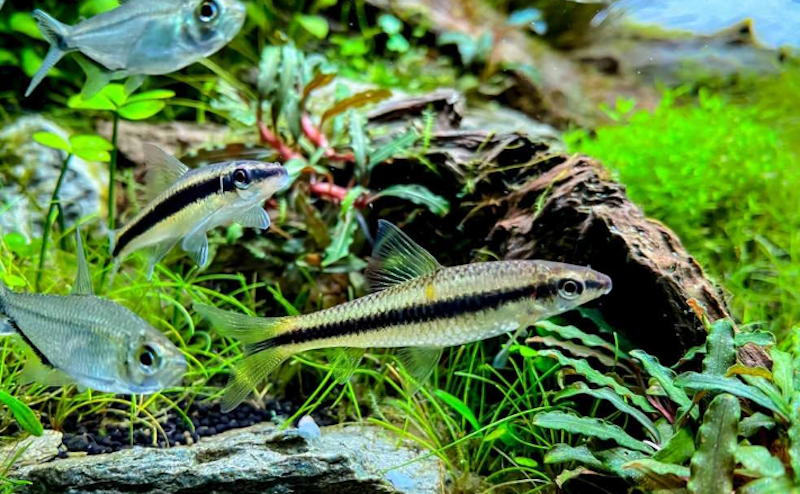
Moreover, you can keep other friendly fish types living with them such as loaches, barbs, giant danios, cichlids, and livebearers. In contrast, aquarists should avoid keeping aggressive or territorial fish like bettas, angelfish, or exodons living in the same environment. Also, growing dwarf shrimp with Siamese algae eater fish is not smart because Siamese algae-eater fish will eat them.
How to set up aquariums for Siamese algae eater fish?
Setting up the habitat for fish is important to ensure that your fish will thrive well in the indoor environment. To ensure your Siamese algae eater fish can settle easily in a new habitat, you should ensure:
- Fish tank should have at least 20 – 30 gallons of water. Especially, they need water parameters between 20 – 26°C (roughly 68 – 80°F), a water pH level of 6.0 – 8.0, and soft to hard water.
- Strong water flow in the tank as these fish originate from wild streams.
- The fish tank should grow more pelagian. Nevertheless, you should modify the number of objects to ensure your fish have space to swim and discover their surroundings.
Chinese algae eater fish
Overview

The Chinese algae eater fish (Gyrinocheilus aymonieri) is a freshwater fish from rivers in Southeast Asia like China, Thailand, and Vietnam. You will be impressed by its appearance with an elongated black or gray body with a white or yellow stripe. Their length can reach up to 28 cm (about 11 inches).
Habits
Chinese algae-eater fish are known as juveniles and hospitable fish. Their primary diet consists of algae and aquatic vegetation. They majorly use their sucker mouth and teeth to graze surfaces. When they become mature, their diet tends to be more omnivorous.
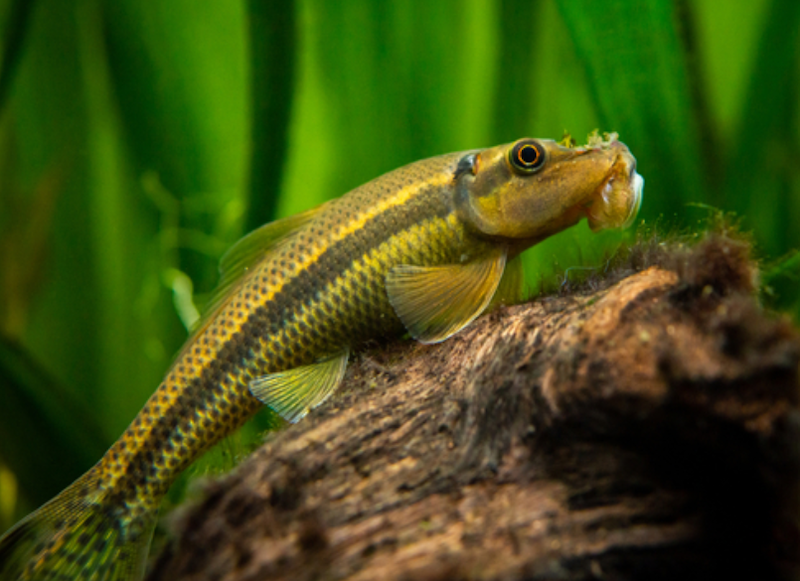
Are Chinese algae eaters aggressive? Yes, they can become territorial when they mature due to their potential territorial behavior. Hence, you should keep them in groups of at least 3 individuals to promote natural schooling behavior and reduce aggression. Moreover, this fish type can also become more aggressive during spawning. A male fish will attack other males in the same group and environment to protect their females.
Habitat
Chinese algae-eater fish can live well with friendly fish. Most below recommended names have hospitable characters, suitable to be tank mates for Chinese algae eater fish:
- Tetras
- Barbs
- Corydoras catfish
- Otocinclus catfish
- Kuhli loaches
- Platies
- Mollies
- Guppies
In contrast, you should avoid choosing territorial fish as Chinese algae-eaters’ tankmates. Those fish can turn into extremely aggressive and attack Chinese algae-eater fish:
- Angelfish
- Gouramis
- Bettas
- Aggressive cichlids (such as Oscars or angels)
- Piranhas
- Knifefish
- Large characins (such as tiger barbs)
- Other algae eaters (may compete for food)
- Fin nippers (danios, rasboras)
How to set up aquariums for Chinese algae eater fish?
Tank size is one of the most important factors when setting up aquariums for Chinese algae eater fish. Normally, a tank with a minimum of 200 liters/53 gallons is the most suitable for comfortably accommodating them. Besides, do not forget to prepare hiding spots such as rocky caves and aquatic plants for them to feel more secure!
Another important factor is the water temperature. To imitate their natural habitat, it should range from 24 – 28°C (roughly 75 – 82°F). Moreover, you should use water parameters to ensure that the water is clean with a pH level of 6.0 – 7.5.
Otocinclus Catfish
Overview
Otocinclus catfish are small algae-eating fish coming from South America. Their size can grow up to 5 cm (about 2 inches). Moreover, they have black lines in their body. Otos need algae or gel foods to graze. Moreover, they should be kept in mature planted tanks. They are hospitable and thrive well in small groups.
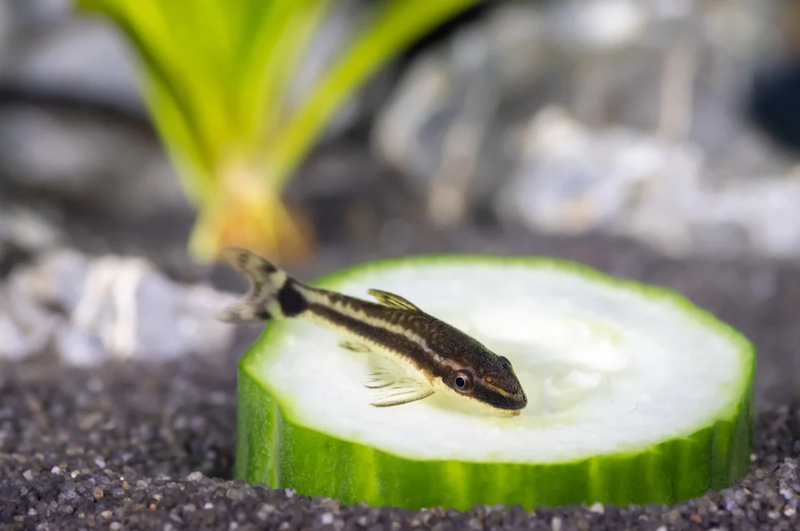
Habits
This is a diurnal fish and they can be active during the day. They would love to graze or rest on plant leaves, hardscapes, and tank walls, which is quite an interesting behavior to watch. Moreover, Otocinclus catfish love to nibble algae and biofilm off smooth surfaces, Especially, they adore eating soft algae like green and brown algae.
However, Otocinclus catfish can become extremely aggressive when there is not enough food for them. This is the reason why you should keep a large number of Otocinclus catfish together. If they are starved, they can eat each other!
Habitat
The best tank mates for Otocinclus catfish include non-aggressive fish below:
- Tetras
- Rasboras
- Corydoras
- Kuhli loaches
- Snails and shrimp.

Nevertheless, there is a list of aggressive fish you should not keep to avoid Otocinclus catfish being bullied and attacked:
- Angelfish
- Gouramis
- Bettas
- Dwarf gourami
- Cichlids
- Plecos.
How to set up aquariums for Otocinclus catfish?
To set up a suitable fish tank for Otocinclus catfish, you should ensure that:
- Water temperature ranges from 21 – 26°C (roughly 70 – 79°F) and water pH level of 6.0 – 7.5.
- Setting up a tank growing lots of algae and biofilm will create a natural food resource for Otocinclus catfish.
- Do not forget to give them hiding spots among plants and decor for the shy fish!
Plecostomus (Plecos)
Overview
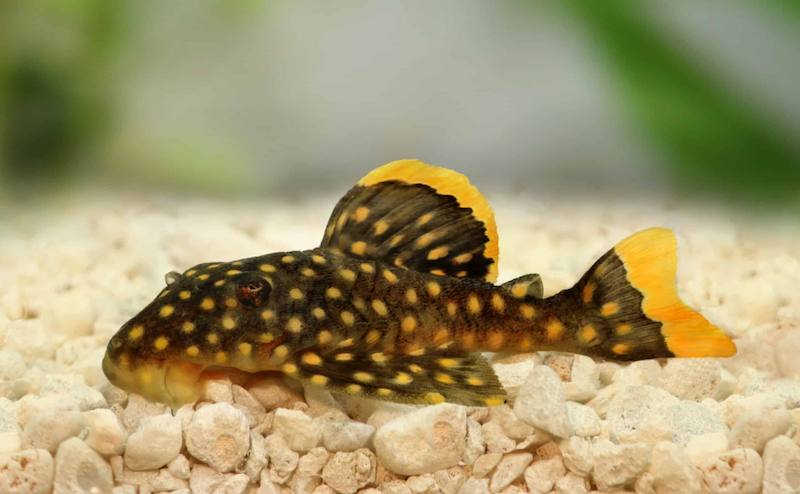
Founded for the first time in South America, Plecostomus – known as plecos or suckermouth catfish, are freshwater bottom-dwelling fish. They have a slim elongated body shape with a flat underside to cling to the surface easily. Plecostomus has a typical ventral mouth like a suction cup, flanked by two pairs of long sensory barbels for hunting food in murky waters.
Habits
Plecostomus love hiding during the day in caves, driftwood, or plants. They like to graze on algae and biofilms to support algae growth control. Besides, this fish can also eat debris such as food waste, fish waste,… to maintain water quality.
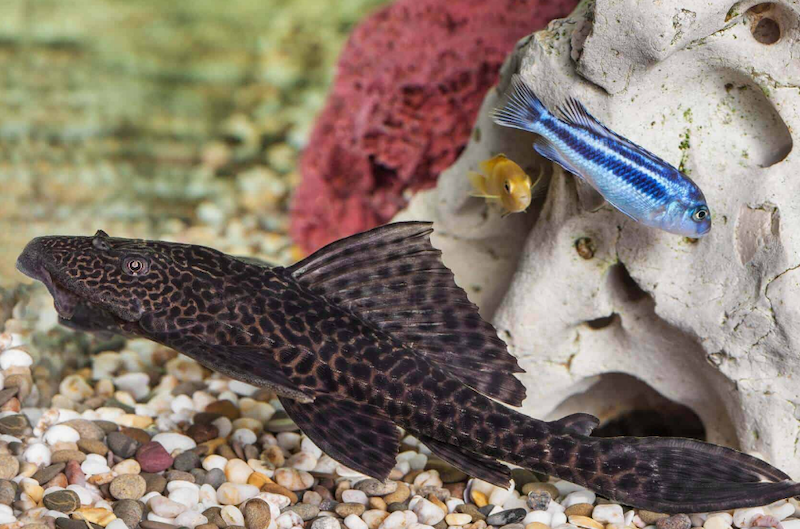
Normally, Plecostomus can easily get angry because they own territorial features. They cannot grow well when there is a danger to their hiding spaces and food sources. Moreover, if the living place does not provide them with enough food, and hiding pots, they will become more aggressive.
Habitat
Plecostomus fish can live a happy life with Tetras, rasboras, corydoras, kuhli loaches, snails, and dwarf shrimp or with other smaller fish. Plecostomus will not be eaten and bullied as those fish have non-aggressive features. However, you should not keep Plecostomus with aggressive fish like cichlids, bettas, goldfish, and angelfish, especially those with bigger sizes.
How to set up aquariums for Plecostomus (Plecos)?
The best aquarium for Plecostomus is a large tank containing 20+ gallons of water. Furthermore, you should prepare hiding places like caves, and wood, and decorate some stones with smooth gravel substrate. You can grow some live plants to provide oxygen or hiding places, which creates a suitable environment for algae growth.
Besides, the average temperature of the water is from 21 – 26°C (nearly 70 – 80°F), the pH water level should be around 6.0 – 8.0, and the hardness of water needs to stand above 5 dGH.
Factors influencing aggression
There are 5 main factors affecting the characteristics and behaviors of algae eaters in aquariums including tank size, hiding pots, breeding period, tankmates, and eating habits.

Tank size
Algae eaters are active and tend to find food around their habitat. If the tank is too big, they have difficulties finding food. In case of setting up a too-small tank with a large number of fish, they will live under depression due to starvation. Therefore, you should prepare a suitable tank size and avoid overcrowded tanks to ensure they can find food and control the number of residents in fish tanks. Algae eaters are less competitive as they usually avoid conflicts when it comes to food hunting.
Hiding spots
Algae eaters love hiding because it helps them feel safe in their habitat. Hence, you should make sure your tank provides enough hiding places for them. However, each species will have different favorite hiding spots such as woods or caves while others immerse themselves in sand and rock. It is essential to research fish habits before setting up the hiding pots.
Breeding season
During the spawning time, male fish tend to go into battles with other males to catch the females’ attention, which makes algae eaters more aggressive. For instance, Chinese algae eater fish are a typical sample for this when they are willing to attack other males living in the same team just to protect their females during the breeding season. Nevertheless, aquarists can avoid this extreme situation by separating male and female fish into different tanks.
Tankmates
Tankmates play an important role in the development of Algae eaters. It is recommended that you keep algae eaters with non-aggressive fish like tetras, barbs, or Corydoras catfish. However, if you keep aggressive fish such as bettas with Algae eaters, it will be a big problem because Algae eaters can easily die under the attack of horrid fish.
Eating habits
Certain algae eaters can become unexpectedly aggressive if they do not have adequate food and nutrition. To prevent this negative behavior, it is essential to feed them on time and the population density in the aquarium during feeding time. Additionally, it is advisable to research the specific dietary needs of each fish species and provide the appropriate amount of nutrition accordingly.
Conclusion
This article has highlighted the top four gentle algae eaters and already answered the question “Are Algae eaters aggressive?”, which will help you make excellent choices for your tank. By selecting the right species and providing proper care, you can ensure a harmonious and thriving aquarium.



